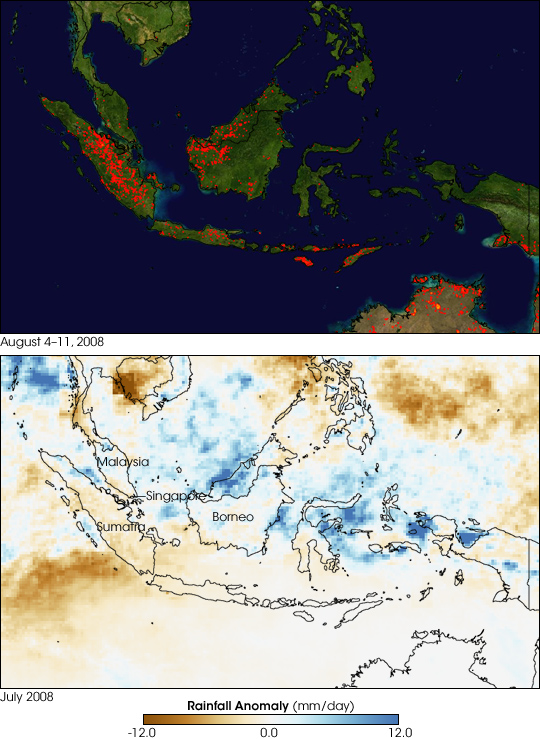


During the May-October dry season, fire often smolders through Indonesia’s tropical forests. Most of the fire is deliberate, set for logging or to clear land for crops or plantations, and more than plants are consumed in the flames. Rich with biomass, the peaty soil burns too, producing intensely smoky fires. On bad days, smoke billows off of the Indonesian islands of Sumatra and Borneo, blanketing major shipping lanes and neighboring countries Singapore and Malaysia. As part of an agreement with its neighbors, Indonesia is striving to reduce the haze pollution by decreasing the number of fires that burn each year.
The challenge is to keep track of the fires set in remote regions, a task perfectly suited to satellite imagery. The Moderate Resolution Imaging Spectroradiometer (MODIS) sensors flying on both the Terra and Aqua satellites detect fires by the heat they produce. Fire locations from MODIS for the week of August 4, 2008, are marked with red dots in the image above. The fire locations are overlaid on the NASA Blue Marble background. According to reports from AFP news service, a dramatic increase in the number of fires burning in Borneo on August 4 led officials to declare the official fire season underway.
Officials were concerned that fires during the 2008 season could be more intense than normal because the dry season had been especially dry. The lower image confirms the drought. Made with data collected by the Tropical Rainfall Measuring Mission (TRMM) satellite, the image shows rainfall measurements for July 2008 compared to average measurements. Areas that received more rain than average are blue, while regions that received less rain are brown. Sumatra and southern Borneo were dry through the month.
Both the government and other organizations will track the number of hotspots detected from space as the dry season progresses, hoping that the drought does not lead to a fire emergency. As part of its agreement with Malaysia and Singapore, Indonesia agreed to reduce the number of hotspots by 50 percent by 2009, 75 percent by 2012, and 95 percent by 2025, said the World Wildlife Fund (WWF). The organization is watching MODIS satellite data to track the government’s progress. The WWF receives alerts from the Fire Information for Resource Management System (FIRMS) at the University of Maryland whenever MODIS sees fires in Sumatra or Borneo. (See Fire Alerts Go Global to read more about the alert system.) The organization is using the fire location data along with photo-like images from the MODIS Rapid Response System to monitor the fire situation.
NASA images created by Jesse Allen, using fire data provided courtesy of the MODIS Rapid Response team, and TRMM rainfall data from the TRMM Science Data and Information System at Goddard Space Flight Center. Caption by Holli Riebeek.